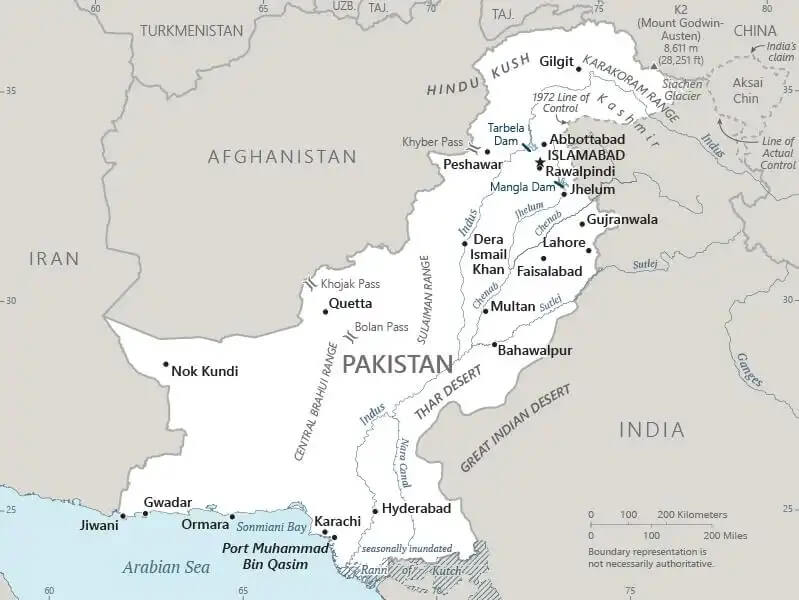World Book
Pakistan
World Book Index
49


With a score of 49, the country is ranked 129th out of 158 countries in the World Book ranking. (more information)
Introduction
Background
The Indus Valley civilization, one of the oldest in the world and dating back at least 5,000 years, spread over much of modern-day Pakistan. The British dominated the region in the 18th century. The separation in 1947 of British India into the Muslim state of Pakistan (with West and East sections) and largely Hindu India was never satisfactorily resolved, and the countries continue to spar over the Kashmir territory.
Geography
Area
total : 796,095 sq km
land: 770,875 sq km
water: 25,220 sq km
Climate
mostly hot, dry desert; temperate in northwest; arctic in north
Natural resources
arable land, extensive natural gas reserves, limited petroleum, poor quality coal, iron ore, copper, salt, limestone
People and Society
Population
total: 252,363,571 (2024 est.)
Ethnic groups
Punjabi 44.7%, Pashtun (Pathan) 15.4%, Sindhi 14.1%, Saraiki 8.4%, Muhajirs 7.6%, Baloch 3.6%, other 6.3%
Languages
Punjabi 38.8%, Pashto (alternate name, Pashtu) 18.2%, Sindhi 14.6%, Saraiki (a Punjabi variant) 12.2%, Urdu 7.1%, Balochi 3%, Hindko 2.4%, Brahui 1.2%, other 2.4%
Religions
Islam (official) 96.5% (Sunni 85-90%, Shia 10-15%), other (includes Christian and Hindu) 3.5% (2020 est.)
Population growth rate
1.86% (2024 est.)
Government
Government type
federal parliamentary republic
Capital
name: Islamabad
Executive branch
chief of state: President Asif Ali ZARDARI (since 10 March 2024)
head of government: Prime Minister Muhammad Shehbaz SHARIF (since 3 March 2024)
Diplomatic representation in the US
chief of mission: Ambassador Rizwan Saeed SHEIKH (since 18 September 2024)
Diplomatic representation from the US
chief of mission: Ambassador (vacant); Chargé d’Affaires Natalie A. BAKER (since January 2025)
Economy
Economic overview
lower middle-income South Asian economy; extremely high debt; endemic corruption; regional disputes with India and Afghanistan hinder investment; falling inflation, IMF relief programs, and strong agricultural output slowly contributing to economic recovery
Real GDP (purchasing power parity)
$1.39 trillion (2024 est.)
$1.346 trillion (2023 est.)
$1.347 trillion (2022 est.)
Real GDP per capita
$5,500 (2024 est.)
$5,400 (2023 est.)
$5,500 (2022 est.)
Exports
$40.219 billion (2024 est.)
$36.215 billion (2023 est.)
$38.967 billion (2022 est.)
Exports - partners
USA 14%, UAE 10%, China 9%, Germany 7%, UK 6% (2023)
Exports - commodities
garments, fabric, refined petroleum, rice, cotton fabric (2023)
Imports
$66.844 billion (2024 est.)
$58.069 billion (2023 est.)
$76.594 billion (2022 est.)
Imports - partners
China 25%, Qatar 11%, UAE 9%, Saudi Arabia 8%, Indonesia 6% (2023)
Imports - commodities
natural gas, refined petroleum, crude petroleum, palm oil, plastics (2023)
Human Development Index
The country's Human Development Index (HDI) is 0.544, ranking it 168th out of 193 countries tested. (more information)
World Happiness Report
The World Happiness Report ranked the country 115th out of 158 countries tested with a score of 4.556. (more information)



